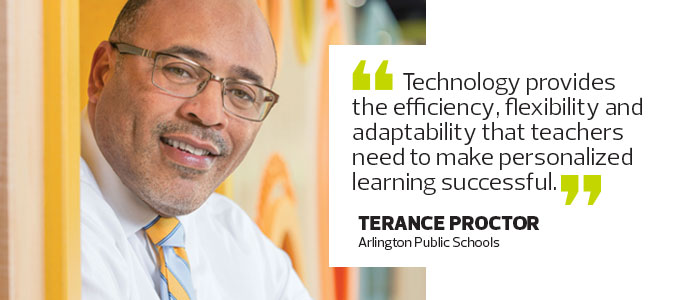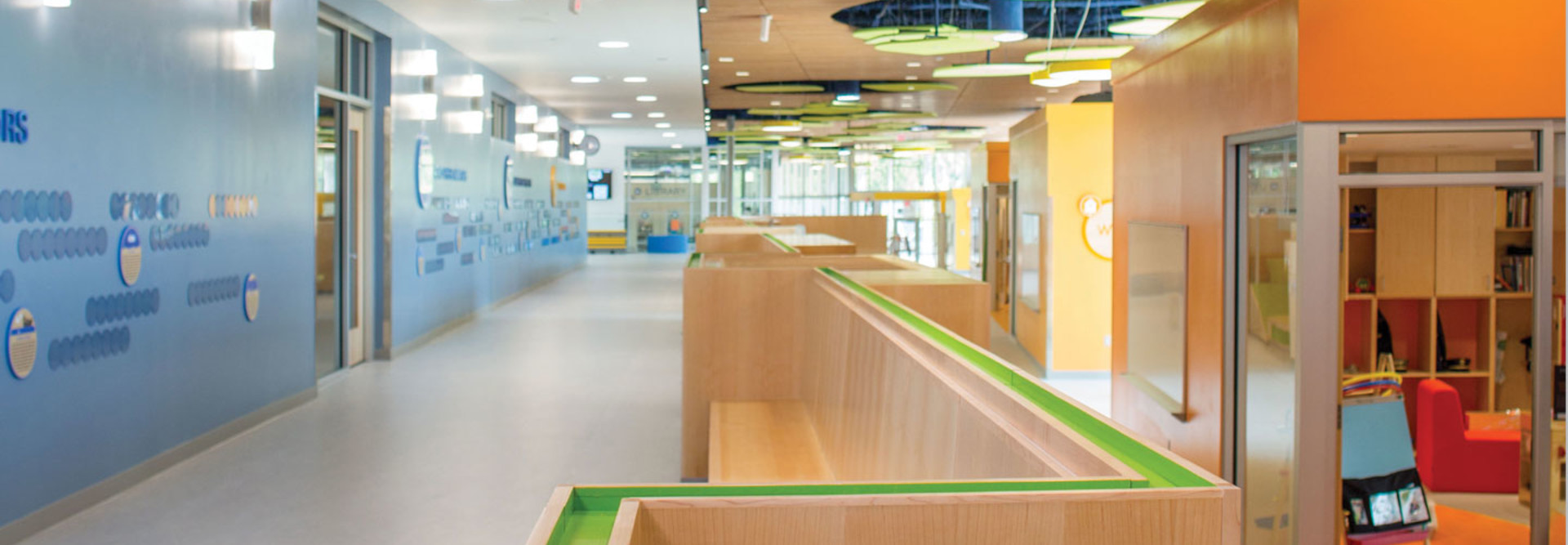Personalized Learning Hinges on Strong Tech Backbone
In a lot of ways, combining technology with curricula is like learning about fractions. Together, the two disciplines create a whole. But in schools nationwide, instructional and technology teams are working in tandem to ensure that this whole adds up to more than the sum of its parts, so that teachers in the classroom can effectively provide individualized learning to their students.
For the technology side of the equation, it’s about “making sure the infrastructure can support any creative possibilities for instruction,” says Terance Proctor, director of technology at Arlington Public Schools (APS) in Virginia.
On the instructional side, it’s about personalizing all aspects of learning with agility, says Tara Nattrass, assistant superintendent for instruction at APS. This academic model relies on each student’s own voice and choices so that teachers can better address the learner’s distinct needs while also setting goals and tracking progress, she explains. Curriculum planners also take into account various instructional approaches, academic support strategies and learning experiences, Nattrass adds.
“It is a way of teaching and learning, but technology provides the efficiency, flexibility and adaptability you need to make it successful,” Proctor says. “We are counting on that to help us increase student engagement, increase student choice, and help us further increase efficiency and eliminate the achievement gap.”

Amplify Personalization with Tech
The concept of customizing instruction to fit the unique personal and individualized needs of each student and give them some choice in how they receive their learning has been an effective practice for years within the exceptional education community, says Kecia Ray, executive director of the Center for Digital Education.
What’s changed, Ray points out, is that mobile, wireless and digital technologies now make it practical for schools like those in Arlington, Va., and elsewhere, to support that model for all students.
“With today’s technology, we can collect data from the student, form an assessment from their interest inventory and interviews, and then analyze that and get a much better idea of how to design instruction to meet individual needs,” Ray says.
Personalized learning is currently being hailed as the future of education. It ranked No. 1 in the top 10 IT priorities listed in the annual Digital School Districts Survey put out by the Center for Digital Education and National School Board Association.
Building a Framework for Digital Learning
While classroom technology is critical, the underlying infrastructure plays a more pivotal role, Proctor says. This type of model requires fast and robust classroom technology so that teachers can provide different students with a variety of delivery options, he says. In a personalized instructional program, teachers are blending learning models — online courses with textbooks and project-based learning — alongside traditional lecture-based and one-on-one assistance.
APS’ Nattrass, who took on her current role with the district this summer, expects that teachers will figure out the blend of technologies that will best serve their students over the coming year.
It took planning to prepare for where APS wanted to take learning, Proctor says. Proctor and his team began by devising and then implementing a scalable technology foundation that would allow the schools to bring in new tools and teaching tactics as the personalized learning pedagogy evolved.
APS officials rolled out a fiber-optic infrastructure to deliver internet services and expanded the wireless infrastructure to a high-speed Aruba wireless network with one or more access points in every classroom. The IT team also installed Wi-Fi in atriums, courtyards and other spaces where students learn and study.
It upgraded the network core by installing a high-capacity Juniper Networks router that will be capable of handling up to 90,000 computing devices by 2017. To protect the data that flows across this newly bolstered network, APS deployed a highly secure Palo Alto Networks firewall and content filter.
Now, the school district is completing its rollout of a one-to-one device program. Each student in grades two through eight will have a tablet, and high school students will receive their own notebook computers.
In anticipation of the increased load on the network, the IT team recently bumped up the school’s internet capacity from 1 gigabit per second to 10Gbps.
Efficiency and Flexibility Are Key
With the technology platform ready, Nattrass has begun working with her curriculum team and APS teachers on plans for rolling out the district’s personalized learning environment.
As this evolves, Nattrass says she expects that APS teachers will leverage new technologies that take advantage of all students having access to devices not only in the classroom but anywhere they roam. APS must set up a framework for incorporating student data reporting and analytics, which are critical to a personalized learning model, she says.
The district has two student assessment systems now. A data warehouse lets administrators, counselors and teachers pull student test performance, attendance and other key information in real time so that it can inform both daily and long-term instruction.

SOURCE: Center for Digital Education and National School Board Association, “Digital District Schools Survey,” August 2015
Student Voice and Choice in All Decisions
Kelly Henderson, executive director of instruction at Metro Nashville Public Schools (MNPS), says today’s focus on personalized learning supported by technology adds a new aspect: the student perspective. “We’ve done a lot of work around this idea of letting students have more input into their learning strategies,” she says.
MNPS embraced the concept several years ago, but adoption varies across the district. Although the IT department successfully upgraded the district’s technology infrastructure to provide the wireless connectivity and internet capacity required, there aren’t enough financial resources available to pay for a one-to-one program for all 82,000-plus students. Still, the district has had several successes in personalizing its teaching programs, Henderson says. In some MNPS high schools, differentiated lesson plans, digital content, blended learning, assessment tools and a bring-your-own-device policy have helped to increase graduation rates.
“Personalized learning, supported by technology, will have a positive impact on students’ engagement, depth of learning, graduation rates, and success in college and the workforce,” she says.
Creating a System of Structured Choice
For Georgia’s Fulton County Schools, a massive charter system that surrounds (but does not include) the city of Atlanta, officials also view personalized learning as the path to increase graduation rates and college and career readiness.
Curriculum and technology officials at FCS worked together to come up with a plan to implement the learning model across its nearly 100 schools and make changes to the network to support it.
The IT department tripled the number of access points in the district — from 3,000 to 9,000. It also boosted internet bandwidth tenfold, and then moved and upgraded the data center to increase its scalability.
“We believe that personalized learning coupled with the right technology extends the reach of the teachers,” CIO Serena Sacks says. “It allows them to build better relationships with students and use analytics and information to inform their teaching practices. ”








